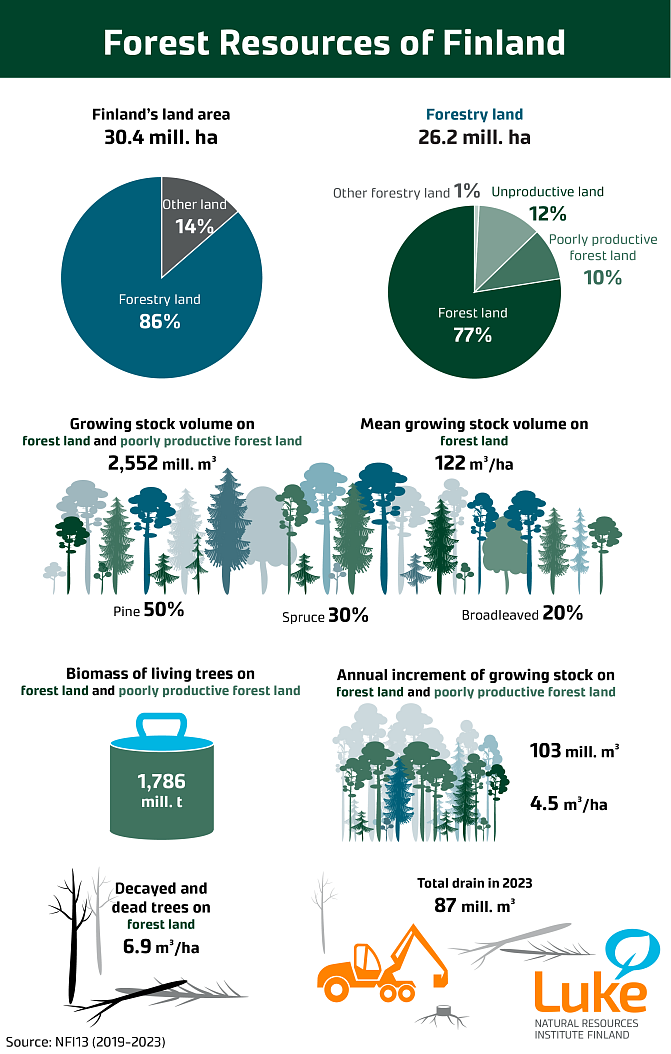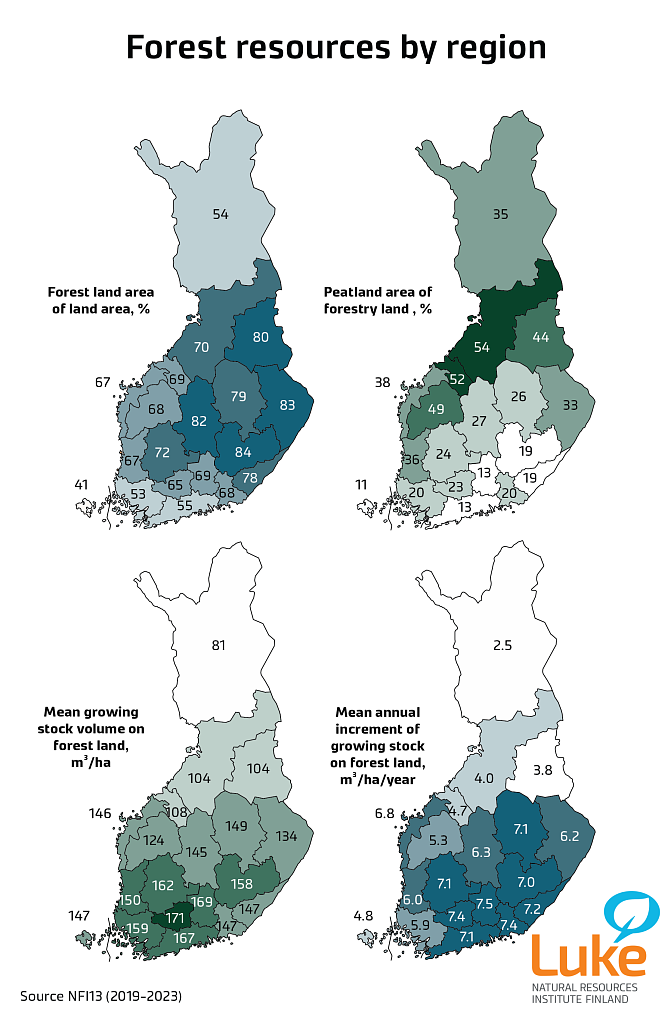Data on forest resources: the volume of the growing stock continues to increase, even though the annual increment has decelerated
According to the most recent data on forest resources, the volume of the growing stock has increased, while annual growth has slowed. Natural tree mortality has increased alarmingly during the 2000s. The data are based on the results of the 13th National Forest Inventory measured in 2019–2023 and completed recently.
According to the National Forest Inventory (NFI) of the Natural Resources Institute Finland (Luke), the volume of the growing stock on forest land and poorly productive forest land is more than 2.5 billion cubic metres and the annual increment is 103 million cubic metres. The volume of the growing stock is now 1.8 times larger than a hundred years ago. While the annual increment of the growing stock has slowed in recent years, it has more than doubled during the last hundred years.
The area of forestry land in Finland is 26.2 million hectares, covering 86 per cent of the total land area. Roughly three quarters of this area consists of productive forest land, while poorly productive forest land accounts for a tenth and completely or nearly treeless non-productive land makes up 12 per cent. The forest area has remained stable during recent decades. However, increased protection has reduced the land area available for wood production. Of forestry land, 23 per cent is not available for wood production.

In Finland, peatlands account for a third of forestry land. The percentage of peatlands is highest in the regions of Northern and Central Ostrobothnia at more than 50 per cent. Correspondingly, the percentage of peatlands is lowest in the Åland Islands, Päijät-Häme and Uusimaa, where they cover only slightly more than a tenth of forestry land. The draining of new peatland areas has practically ceased. During the ten-year period preceding the NFI13 measurements, the draining of previously undrained peatland areas covered an average of 6,000 hectares per year.
Of forests on forest land, nearly two thirds are dominated by pine, a quarter by spruce and ten per cent by deciduous broadleaves. In addition, 45 per cent of forests are mixed deciduous and coniferous forests with at least ten per cent of mixed trees, and 14 per cent are forests with at least 25 per cent of mixed trees.
The volume of the growing stock has increased by more than 70 million cubic metres
The volume of the growing stock on forest land and poorly productive forest land totals 2,552 million cubic metres, of which two thirds are in Southern Finland. After the previous inventory (2014–2018), the volume has increased by 77 million cubic metres. This means that the increment has been higher than the volume of removals and natural tree mortality.
The mean volume of the growing stock, i.e. the number of trees per one hectare of forest land, is 122 cubic metres per hectare. It shows significant variation from one region to the next: the mean volume is highest in Kanta-Häme (171 cubic metres per hectare) and lowest in Lapland (81 cubic metres per hectare).

Forest ageing, drought and damage decelerate tree growth
The annual increment of the growing stock on forest land and poorly productive forest land is 103 million cubic metres, an average of 4.5 cubic metres per hectare. In the previous inventory, the annual increment was estimated to be nearly five million cubic metres higher.
The annual increment is highest in Lapland at 13.2 million cubic metres, even though annual mean growth is lowest there at 2.0 cubic metres per hectare. In Päijät-Häme, annual mean growth is 7.5 cubic metres per hectare but, because of the region’s small size, the annual increment is only 3.0 million cubic metres.
“In recent years, slower growth has also been reported in Sweden, Norway and most recently in Germany. According to studies, this deceleration is caused by the ageing of forests past the phase of fastest growth, as well as drought and forest damage. It should also be noted that the weather conditions were better than average during the previous inventory, i.e. NFI12", says Principal Scientist Kari T. Korhonen who is in charge of Finland’s National Forest Inventory.
Natural tree mortality has increased significantly
Natural tree mortality is 8.8 million cubic metres a year. Compared with the previous inventory, mortality has increased by 1.8 million cubic metres. The estimate of tree mortality has roughly doubled in the 2000s.
“The increase in tree mortality cannot be explained by nature management measures, such as leaving retention trees in clearcutting areas. Furthermore, the forest damage area has not increased as much. In contrast, the number of individual trees died in different parts of forests has increased alarmingly. The exact reason is not known, but the situation should be monitored. Luke’s forest damage monitoring projects will provide more detailed data on tree damage,” says Kari T. Korhonen.
Then again, dead trees are important considering forest diversity. The average volume of dead trees on forest land is 6.9 cubic metres per hectare, which is a fifth more than in the previous inventory. The volume of dead trees has increased by 22 per cent to 5.5 cubic metres per hectare in Southern Finland and by 13 per cent to 8.5 cubic metres per hectare in Northern Finland. In Southern Finland, the volume of dead trees has increased throughout the 2000s. The volume of dead trees decreased previously in Northern Finland, but it has now increased in recent years.

More diversity indicators for the National Forest Inventory
The National Forest Inventory will continue with a five-year cycle as before in such a way that new measurement results will be produced each year.
“We have received significant additional funding from the Finnish Forest Foundation to develop more forest diversity indicators for the inventory,” says Senior Scientist Minna Räty.








